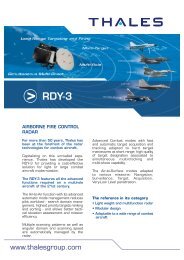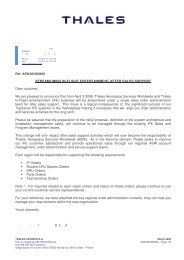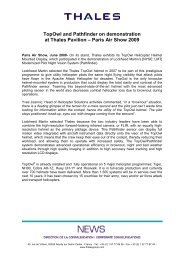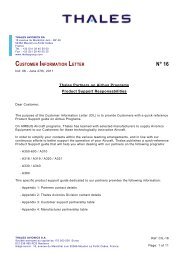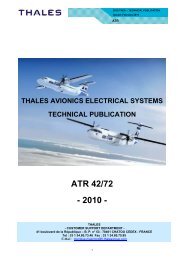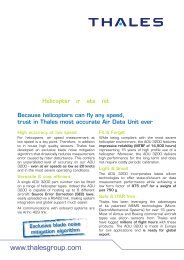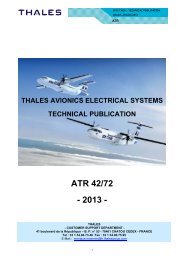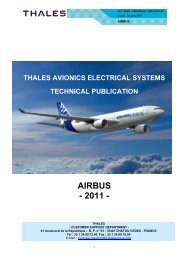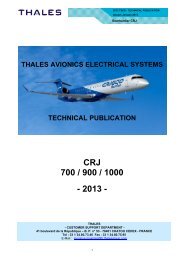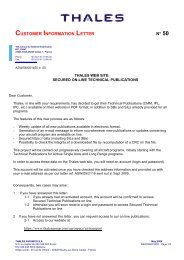Low loss high definition conductor line in LTCC
Low loss high definition conductor line in LTCC
Low loss high definition conductor line in LTCC
You also want an ePaper? Increase the reach of your titles
YUMPU automatically turns print PDFs into web optimized ePapers that Google loves.
III MEASUREMENT APPROACHIII-1 TEST STRUCTURERF measurements were performed on strip<strong>l<strong>in</strong>e</strong> (embedded <strong>l<strong>in</strong>e</strong>). With this k<strong>in</strong>d of structurethe field is conf<strong>in</strong>ed [5]-[7]. This transmission <strong>l<strong>in</strong>e</strong> is particularly adapted for <strong>conductor</strong> <strong>loss</strong>characterisation [8]. So, it was possible to study the follow<strong>in</strong>g parameter effects on the<strong>conductor</strong> <strong>loss</strong>es: DC electrical resistivity, <strong>l<strong>in</strong>e</strong> edge ripple and dielectric-<strong>conductor</strong> <strong>in</strong>terfaceroughness.70 µmAIR180 µmGroundplane<strong>LTCC</strong>Embedded<strong>l<strong>in</strong>e</strong>180 µmFigure 1: strip<strong>l<strong>in</strong>e</strong> structure used for electrical resistivity, <strong>l<strong>in</strong>e</strong> edge ripple and <strong>in</strong>terfaceroughness, as well as electrical <strong>loss</strong>es characterisation.III-2 DC ELECTRICAL RESISTIVITYThe DC electrical resistivity has a significant impact on RF <strong>loss</strong>es. The <strong>l<strong>in</strong>e</strong> resistivity is givenby ρ = R*(S/L) with R the measured resistance, L the <strong>conductor</strong> length and S the <strong>conductor</strong>cross section area. In order to be <strong>in</strong> a similar configuration to that of a strip<strong>l<strong>in</strong>e</strong>, a buriedmeander <strong>l<strong>in</strong>e</strong> hav<strong>in</strong>g 70 µm width and 25 cm length was <strong>in</strong>cluded <strong>in</strong> the test vehicle. Theresistance was measured us<strong>in</strong>g a <strong>high</strong> accuracy four wire ohmmeter Hy-track 100D.S is the average section area, determ<strong>in</strong>ed by mak<strong>in</strong>g 10 cross sections of the <strong>l<strong>in</strong>e</strong> and us<strong>in</strong>g anappropriated image process<strong>in</strong>g tool to calculate the section area.
III-3 LINE EDGE RIPPLEIn addition to the <strong>conductor</strong> DC electricalresistivity, the non regular shape of the <strong>l<strong>in</strong>e</strong><strong>in</strong>troduces electrical <strong>loss</strong>es <strong>in</strong> RF. Wecalled this phenomenon “<strong>l<strong>in</strong>e</strong> edge ripple”.See fig 2. To quantify the <strong>l<strong>in</strong>e</strong> edge ripple,thirty 70 µm buried <strong>l<strong>in</strong>e</strong>s were <strong>in</strong>cluded.Successive sections of these <strong>l<strong>in</strong>e</strong>s wereperformed to measure the correspond<strong>in</strong>gwidths (W 1 , W 2 , …W i, … Wn). The <strong>l<strong>in</strong>e</strong>edge ripple is def<strong>in</strong>ed as the standarddeviation of Wi.Perfect <strong>l<strong>in</strong>e</strong>TOP VIEWWidth W 1Width W 2...Width W iFigure 2: ideal and real <strong>l<strong>in</strong>e</strong>sL<strong>in</strong>e edge ripple affect<strong>in</strong>gelectrical <strong>loss</strong>esIII-4 INTERFACE ROUGHNESSThe topography of the <strong>in</strong>terface between <strong>conductor</strong> and dielectric also contributes <strong>in</strong> RF<strong>loss</strong>es. Most of EM simulation tools takes <strong>in</strong>to account this parameter. In order to characterisethe topography of the <strong>conductor</strong>-dielectric <strong>in</strong>terface, the quadratic roughness Rq has beenmeasured. S<strong>in</strong>ce the transmission <strong>l<strong>in</strong>e</strong> is buried, the substrates were polished follow<strong>in</strong>g the z-axis down to <strong>in</strong>ternal <strong>conductor</strong>s. Then, the silver <strong>conductor</strong>s were chemically dissolved.Thus, it was possible to really measure the roughness (Rq) with a Talysurf Series, RANKTAYLOR HOBSON. A cut-off of 0.8 mm was used and measures were performed on 8 cutoff(6.4 mm).Internal <strong>l<strong>in</strong>e</strong>Internal <strong>l<strong>in</strong>e</strong> afterpolish<strong>in</strong>gInternal <strong>l<strong>in</strong>e</strong> –dielectric<strong>in</strong>terface after dissolutionFigure 3: Method for roughness measurement of <strong>in</strong>ternal <strong>l<strong>in</strong>e</strong>s.
IV CHARACTERISATION RESULTSIV-1 PHYSICAL CHARACTERISATION RESULTSDC electrical ResistivityStd Adv Photo Solid silverresistivity (10 -8 Ω.m) 2.1 1.8 2.0 1.6The DC electrical resistivity is affected by the glass phase ratio and the gra<strong>in</strong> structure of thepaste. The DC electrical resistivity <strong>in</strong>creases with the glass phase ratio. F<strong>in</strong>er gra<strong>in</strong>s <strong>in</strong>creasethe contact surface and consequently improve the conductivity.Paste gra<strong>in</strong> structureStandard (glass + silver) Advanced (pure silver) Photo-imageable (glass + silver)scale (x 5000) : 2 µmPhoto 1: gra<strong>in</strong> structure of the silver powdersThe advanced paste, which has the best conductivity, conta<strong>in</strong>s pure silver and features thef<strong>in</strong>est gra<strong>in</strong>s. The photo-imageable paste has a similar gra<strong>in</strong> structure but conta<strong>in</strong>s glass phase.Its DC electrical resistivity is 11% <strong>high</strong>er than the advanced one. The standard paste has theworst granulometry and conta<strong>in</strong>s also glass phase. It has the <strong>high</strong>est resistivity: + 17%referr<strong>in</strong>g to the advanced material.L<strong>in</strong>e edge rippleL<strong>in</strong>e edge ripple quantified by thestandard deviation (µm)Std Adv Photo6.43 2.37 2.29
Cross section viewThe smallest <strong>in</strong>terface roughness is obta<strong>in</strong>ed with thephoto-imageable paste while the standard paste givesthe <strong>high</strong>est roughness. The measured values areconsistent with the optical analysis of the cross sections.Photo 3: <strong>conductor</strong>-dielectric <strong>in</strong>terface for the Advanced paste.IV-2 RF CHARACTERISATIONRF measurements were performed with a vector network analyser and two GSG millimeterwavecoplanar probes. Measurements were calibrated with a coplanar SOLT standard kit.0,35Strip<strong>l<strong>in</strong>e</strong> attenuationv. frequency & pastesStdPhotoAttenuation(dB/cm)0,300,250,200,150,10Adv0,051 2 3 4 5 6Frequency(GHz)Figure 4: Attenuation versus frequency for 3 conductive materials.
ATTENUATION (dB/cm)1 GHz 2 GHz 3.5 GHzStd 0.13 0.17 0.24Adv 0.08 0.12 0.18Photo 0.096 0.13 0.2Table 1: Attenuation versus frequency and conductive materials.The measured <strong>loss</strong>es are relatively <strong>high</strong> due to the fact that the characterisation is based on astrip<strong>l<strong>in</strong>e</strong> structure with very f<strong>in</strong>e <strong>l<strong>in</strong>e</strong> (70µm).Over the 1 to 6 GHz frequency range, the two none standard pastes show significantimprovements. Compared to the standard one, the advanced paste reduces RF <strong>loss</strong>es by 29.4%@ 2GHz and the photo-imageable paste reduces RF <strong>loss</strong>es by 23.5% @ 2GHz.IV-3 SYNTHESIS OF PHYSICAL AND RF MEASUREMENTSSome important physical and electrical parameters for <strong>l<strong>in</strong>e</strong> <strong>loss</strong>es were measured:• The DC resistivity gives a measure of the “<strong>in</strong>tr<strong>in</strong>sic” material conductivity.• Accord<strong>in</strong>g to RF current locations, <strong>l<strong>in</strong>e</strong> edge irregularities may have a strong <strong>in</strong>fluence on<strong>l<strong>in</strong>e</strong> <strong>loss</strong>es.• In the upper frequency range, when the sk<strong>in</strong> depth beg<strong>in</strong>s to be very <strong>in</strong>fluential, the<strong>conductor</strong> surface roughness is also a key parameter.These features are summarised <strong>in</strong> the follow<strong>in</strong>g table:Std Adv PhotoResistivity (10 -8 Ω.m) 2.1 1.8 2.0L<strong>in</strong>e edge ripple (µm) 6.43 2.37 2.29Mean Rq (µm) 0.81 0.73 0.63Attenuation (dB/cm @ 2 GHz) 0.17 0.12 0.13Table 2: Measured strip<strong>l<strong>in</strong>e</strong> features.
V ANALYSIS OF RESULTSV-1 ADV AND PHOTO PASTES VERSUS THE STD ONEAs shown <strong>in</strong> table 2, all electrical and physical parameters are most favourable <strong>in</strong> the twonone standard paste case. The most significant difference appears on the <strong>l<strong>in</strong>e</strong> edge ripple.Advanced and photo-imageable materials give far better RF <strong>loss</strong>es <strong>in</strong> comparison with thestandard one. So the <strong>l<strong>in</strong>e</strong> edge ripple seems to be the most sensitive parameter concern<strong>in</strong>g RF<strong>loss</strong>es.V-2 PHOTO VERSUS ADVPhoto-imageable <strong>conductor</strong> RF <strong>loss</strong>es are not as good as expected. The photo-imageableprocess is <strong>in</strong>tended to give very sharp <strong>l<strong>in</strong>e</strong> edges <strong>in</strong> comparison with the screen-pr<strong>in</strong>t<strong>in</strong>gprocess. Nevertheless, <strong>high</strong>-resolution <strong>l<strong>in</strong>e</strong>s achieved with this process suffer from edgedeformations <strong>in</strong>troduced dur<strong>in</strong>g the lam<strong>in</strong>at<strong>in</strong>g phase. In fact, photo-imageable <strong>l<strong>in</strong>e</strong> edges areonly slightly better than the advanced one.The <strong>in</strong>terface roughness is better for the photo-imageable process as well. Neither thisparameter can expla<strong>in</strong> the RF <strong>loss</strong>es difference.The rema<strong>in</strong><strong>in</strong>g advantage of the advanced material is the DC resistivity. Table 3 shows howRF <strong>loss</strong>es <strong>in</strong>crease with 10% more resistivity.10 % resistivity <strong>in</strong>creaseLoss <strong>in</strong>creaseFreq(GHz)v.frequency1 2.4 %4 1.9 %10 1.5 %Table 3: Result on strip<strong>l<strong>in</strong>e</strong> simulation. Loss <strong>in</strong>crease versus frequency for 10 % resistivity<strong>in</strong>crease.
As shown on table 3, the resistivity difference alone cannot expla<strong>in</strong> the RF <strong>loss</strong> differencebetween advanced paste and photo (+10 % measured at 2 GHz). This conclusion opens thequestion on the impact of other parameters on RF <strong>loss</strong>es. We th<strong>in</strong>k the glass phase <strong>in</strong>cluded <strong>in</strong>the photo-imageable paste may have a significant <strong>in</strong>fluence on the RF performance. Indeedthe diffusion of glass first occurs on the <strong>conductor</strong>-dielectric <strong>in</strong>terface. As the frequency<strong>in</strong>creases, the sk<strong>in</strong> depth decreases. Therefore, a larger fraction of the total current is disturbedby the <strong>in</strong>terface roughness and could be disturbed by the glass phase as well. Further analysesare necessary to study <strong>in</strong> details the impact of this glass phase.VI CONCLUSIONThis study demonstrated that the direct screen pr<strong>in</strong>t<strong>in</strong>g process with an advanced paste allowto produce <strong>conductor</strong> <strong>l<strong>in</strong>e</strong>s featur<strong>in</strong>g:• 70µm ± 10µm width,• <strong>l<strong>in</strong>e</strong> edge ripple similar to the photo-imageable process one,• better DC electrical resistivity,• significant reduction of RF <strong>loss</strong>es: 0.12dB/cm @ 2GHz compared to 0.17dB/cm forstandard paste.Moreover, <strong>in</strong> order to study the correlation between physical parameters and RF properties, anew methodology was established allow<strong>in</strong>g to characterise the DC electrical resistivity, the<strong>in</strong>terface roughness and the edge ripple of <strong>conductor</strong> <strong>l<strong>in</strong>e</strong>s.The <strong>l<strong>in</strong>e</strong> edge ripple appears to have the most significant impact on RF <strong>loss</strong>es <strong>in</strong> the 1 to 6GHz range.The considered physical parameters do not allow to fully expla<strong>in</strong> the less good RFperformance of the photo-imageable process. The glass phase <strong>in</strong>cluded <strong>in</strong> the photoimageablepaste may have a significant impact. Further work is planned to verify thisassumption.
REFERENCES[1] R. K. Hoffmann. Handbook of Microwave Integrated Circuits. Norwood, MA; ArtechHouise, 1987.[2] K. C. Gupta, R. Garg and L. J. Babi, Microstrip L<strong>in</strong>es and Slot<strong>l<strong>in</strong>e</strong>s. Norwod, MA; ArtechhOuse, p 51, 1979.[3] J. R. Brews, Transmission <strong>l<strong>in</strong>e</strong> models for <strong>loss</strong>y waveguide <strong>in</strong>terconnections <strong>in</strong> VLSI,IEEE Trans. Electron Devices, vol. ED-33, pp 1356-1365, Sept. 1986.[4] T. C. Edwards, Foundations for Microstrip Circuit Design, New York; Wiley, 1981.[5] C.L. Holloway and E. F. Kuester, Power Loss associated with Conduct<strong>in</strong>g andsuperconduct<strong>in</strong>g rough <strong>in</strong>teraces, IEE tarns. On microwave theory and tech., vol.48,n°10,Oct.2000.[6] M. E. Goldfarb and A. Platzer, Losses <strong>in</strong> GaAs microstrip, IEEE Trans. On microwavetheory and tech., vol 38, n°12, dec.1990[7] P. Troughton; Measurement techniques <strong>in</strong> microstrip, Electronics letters, vol 5, n°2, jan.1969[8] L. Chai and M. Janezic and al., Characerization of <strong>LTCC</strong> material system at microwavefrequencies, IMAPS 2001.




